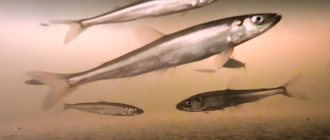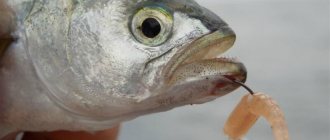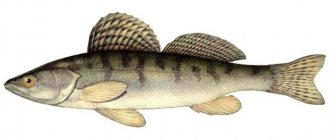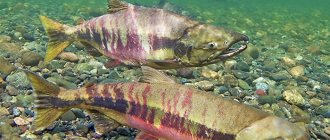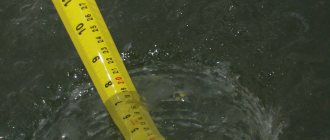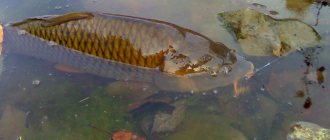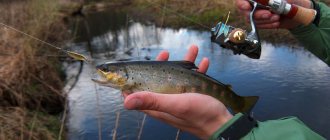Smelt is a small silvery fish with the smell of fresh cucumber. This fish belongs to the smelt family, a species of ray-finned fish. It cannot be confused with other fish because of its smell. If you close your eyes, ask someone to identify an object by smell and let them smell this fish, everyone will say that it is a cucumber or something similar to a cucumber. It is the smell that is the most distinctive feature of smelt, which prevents it from being confused with other fish.
The smelt's body is spindle-shaped . The scales are small and fall off easily. Some subspecies do not have scales. Instead of scales, their bodies are covered with skin, which during spawning is also covered with tubercles. This fish has a large mouth.
There are many subspecies of fish in the smelt family. Let's describe the most common of them:
- Asian smelt;
- Far Eastern;
- European smelt.
It must be added that this is a commercial fish. In addition, it often acts as an object for amateur or sport fishing.
Kinds
This small fish belongs to the smelt family. It also includes the familiar capelin.
There are several varieties of smelt, which differ in size and lifespan. This:
- Smelt (European species). Its weight reaches an average of 6-8 grams, size from 9 to 10 centimeters, life expectancy up to three years. This is the smallest representative.
- Asian (American) catfish. It grows up to 35 centimeters, weighing up to 350 grams per individual, lifespan up to 11 years, the largest representative.
- Saltwater smallmouth. This is the Far Eastern smelt. It is medium in size, up to 25 centimeters in length, weighing up to 160 grams. Lifespan is up to 8 years.
The Far Eastern smelt differs from the other two species in having a smaller mouth, a forward lower jaw, and a shorter dorsal fin.
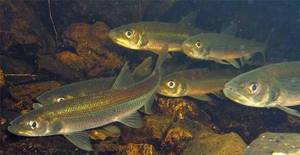
Smelt in cooking
Fried smelt with a crispy crust, the bones of which are tender, and the meat is juicy and fatty, leaves few people indifferent. Moreover, the taste of the fish, although specific, is very pleasant.

During cooking, cooks remove the head of the fish, leaving behind the bones and tail fin. Smelt is not only fried, it is also suitable for drying, hot smoking, and salting. Some people prefer to pickle it like a herring, rolling it into thin tubes. And what kind of soups can be made from smelt! The broths are not particularly rich, so they are excellent for dietary nutrition.
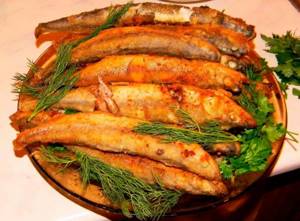
Smelt goes well with many foods:
- Vegetable and butter.
- Vegetables: potatoes, onions, sweet peppers.
- Alcoholic drinks: white wine, beer.
- Unsweetened flour products, crackers.
- Chicken and quail eggs.
- Spices and seasonings - pepper, bay leaf, cloves.
- Lemon sauce.
- Dairy products: hard cheeses, cream.
- Mushrooms, including champignons.
This is interesting!
Smelt is prepared differently for different world cuisines. For example, cooks in Northern Germany like to fry it with butter and bacon, after rolling it in rye flour. Russian and North American chefs do the same thing, but use wheat flour. And in Japan, the popular dish is “shishamo” - grilled smelt, and caviar is used in making sushi.
Smelt is a small fish of great commercial importance. Its popularity is increasing due to its wide distribution and unusual taste.
What does it feed on, how does it spawn?
Smelt feeds mainly on zooplankton, but will not refuse the eggs of its relatives, and can also feast on young animals.
Smelt eats most of all in summer and autumn. This happens near the shores of its habitat.
The fish reaches sexual maturity in the first and second years of life. In all 8 years, she spawns only three times. In the southern regions of its habitat, spawning takes place from April to May, in the northern regions - in June.
St. Petersburg fishermen go fishing for smelt as early as December. At this time, only small specimens can be caught, and the catch will be small. For larger prey you need to go in January and February.
Fishing for smelt is exciting and interesting, especially when the bite is active. Let's get acquainted with the manner of catching smelt.

Smelt

But sometimes he prefers black or gold hooks. To catch smallmouth smelt, hooks Nos. 14-16 are usually used, while catfish ( Zubar ) can be caught on hooks No. 10-12. The quality of the hook, the degree of polishing and the sharpness of the sting are the main components of success. About twenty years ago, a small piece of foam rubber was attached to hooks, and baits of dirty green and lemon yellow colors “worked” best.
Then “beards” came into fashion among fish - hooks with a bunch of green, red or yellow nylon threads. Fishermen stopped buying soft New Year's toys and switched to girlish ribbons. But “beards” are becoming a thing of the past, now fishermen go to the pharmacy: they need rubber - green, yellow and red. The efficient Chinese even released a special set of rubber products “for fishing.”
Animal baits, as a rule, are not used when catching smelt, although catfish ( Zubar ) sometimes take a seaworm or earthworm. Sometimes anglers hook tiny pieces of mussels or squid onto their hooks, but there are always specialists who are just as good at fishing with elastic bands or “beards.”
True, one day in January, when there was a complete lack of bites, I had the opportunity to catch a piucha on Barabashevka using a very small maggot, which the fish took greedily, while they did not peck at all on artificial decorations. All these tricks are not needed in the spring, when fresh schools approach the shore. The fish takes frantically, sometimes on bare hooks, the nod suddenly twitches even on a fishing rod left unattended.
DIY bait for Far Eastern smelt
For any fishing, you need to use bait that attracts schools of fish to the fishing spot. If you try and lure the fish, it will bite better, and this is a guarantee of a catch.
Smelt is a special animal. Bait for her is a separate topic that needs to be considered in more detail. We want to tell you exactly what bait should be used and how to do it.
In winter, Far Eastern individuals enter bays and river mouths, where the depths are relatively shallow, so the fishing areas are covered with a reliable layer of ice. Smelt is a small, but predatory fish. Therefore, to catch it, it is worth using live or imitation live gear. Live food should also be present in the bait.
In winter, Far Eastern smelt swims under the ice in search of plankton. She is especially interested in krill. You can use cunning to lure the fish to your fishing spot using purchased krill. In stores for fishermen, this product is sold frozen, and the manufacturer is most often China or Japan.
Many fishermen, wanting to increase the volume of complementary food, make it themselves, adding other products to the krill. The most commonly used is maggot. It can be clean or tinted.
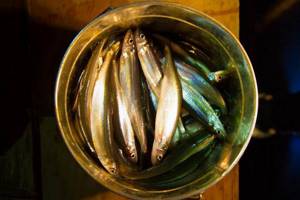
You can add minced meat, fish shavings, shrimp shell and crab powders to the krill. Turmeric is a great idea for complementary feeding. For this purpose, regular flour, milk powder or fine sand can be used.
Unknown smelt
The next season has already opened, and everyone can enjoy ice smelt. “Pisuch”, or “borage”, as avid fish lovers call this fish, is the most common catch. Nikolai KOLPAKOV, Candidate of Biological Sciences, Head of the Ecosystem Research Sector of Bioresources of Coastal Waters of the TINRO-Center, told us with a scientific approach about the extraordinary properties of the most ordinary inhabitant of the seas and other unknown facts from the life of the smelt family.
There are four species of smelt in the Far East. The sea smelt Hypomesus japonicus lives in the Bering (Karaginsky Bay, Corfu Bay), Okhotsk (Tauyskaya Bay, Yamskaya and Iretsky estuaries, western and southern parts), Japanese (along the mainland coast: south to Wonsan; along the Japanese Islands: south to Sangar Strait) and the Yellow (Zhifu) seas. It is found in southeastern Kamchatka (Avacha Bay), the southern Kuril Islands and off the coast of Hokkaido.
The habitat of the common smallmouth smelt Hypomesus olidus covers the Arctic seas (Kara, Laptev, East Siberian, southern part of Chukotka, Beaufort), as well as the Pacific coast: from the Bering Strait to Hokkaido Island and northern Primorye (Samarga River, Lake Burnoe, Amgu river) off the coast of Asia and the bay. Alaska east to the river. Koper, hall. Prince William off the coast of America. It is this fish that we call “borage” because of its characteristic smell. The fact is that it feeds on algae growing on stones, which give fresh fish a specific aroma. This fact was discovered by the Japanese, who noticed that artificially grown smelt did not have a characteristic odor. Further research confirmed the version about the special nutrition of borage.
Japanese smallmouth smelt Hypomesus nipponensis lives in the river basin. Amur, Tatar Strait, along the mainland coast of the Sea of Japan, found from the river. The silverfish reaches Wonsan (North Korea), in the southern part of the Sea of Okhotsk, lives on South Sakhalin, the southern Kuril Islands, in Japan it is known on the islands of Hokkaido and Honshu, and also lives in the Yellow Sea; introduced into many reservoirs in Japan and California.
Pacific toothed smelt, the so-called “catfish”, or “catfish”, Osmerus dentex, is distributed along the coasts of the Arctic (White, Kara, Laptev, East Siberian and Chukchi seas and the Beaufort Sea) and the Pacific Ocean: Bering, Okhotsk and Japanese (along the mainland : south to Wonsan, North Korea; along the islands: south to Toyama Bay (Honshu Island) seas, southeastern Kamchatka, Kuril Islands, Pacific waters of Japan to Honshu Island; off the coast of North America - Alaska Bay, southeast to Hecate Point, Oregon.
Smelt as it is
Smallmouth smelt
(other names - Japanese smallmouth smelt, Smallmouth smelt, Small smelt, Borage, surf, mongrel) - a coastal pelagic species. Does not make long migrations. In summer it lives at depths of up to 60 m, in winter it comes closer to the shore - at 20-30 m. It is the largest of the smallmouth smelt; its maximum length is 26 cm, weight - 168 g. In the waters of northern Primorye, at the age of one to six years, smallmouth smelt reaches an average length of 6.4 to 23.1 cm. Females are usually larger than males, and they live longer. It is interesting that the marine smallmouth smelt, within its range from south to north, exhibits an increase in maximum size, a more complex age structure, and a decrease in growth rates. For example, in the waters of Hokkaido its length reaches 19 cm, age - 3 years, in the hall. Peter the Great - 23 cm and 5+ years, in the waters of Kamchatka - 24.8 cm and 8 years.
Smallmouth smelt matures at the age of 2-3 years. Breeds (typical form) on desalinated areas of beaches with coarse sand, protected by reefs or rock fragments, confined to the mouths of small fresh watercourses, sometimes in coastal brackish lakes. In Peter the Great Bay and northern Primorye, a phytophilic form of smallmouth smelt is found, laying eggs on algae. Spawning of marine smallmouth lasts about a month at a water temperature of 7-10 degrees C, the most intense spawning is observed at 9-10 degrees. Within the range from south to north, spawning dates shift from March-April to May-June. At first, males dominate the spawning grounds; by the end of spawning, the proportion of females increases (up to 94%). From the beginning to the end of spawning there is a decrease in the average age and size of the spawners.
The fertility of sea smallmouth smelt varies between 8-50 thousand eggs (northern Primorye).
Common smallmouth smelt
within its range it is represented by three ecological forms: migratory, lake and lake-river. The migratory form feeds in the lower reaches of rivers and coastal sea waters, enters rivers to reproduce (in the Amur - from mid-February to May), winters in the lower reaches of rivers and shallow bays. In small rivers, the length of spawning migration does not exceed several kilometers; in large rivers (Tym, Amur) it can reach 70-100 km or more. The lake-river form migrates from lakes to rivers for wintering in the fall, and from rivers to lakes for feeding and spawning in the summer. Lake smelt spends its entire life in lakes. The anadromous form reaches a length of 18 cm, a weight of 50 g and an age of 6 years.
Common smallmouth smelt spawns in the spring; mass spawning in the rivers of Sakhalin (anadromous form) is observed in late May - early June at a water temperature of 8.4-10.3 degrees C. Eggs are laid on sand and pebble soil and aquatic vegetation.
Common smallmouth smelt matures at the age of 2-3 years. Small females lay about 2,000 eggs, and large females lay more than 10 thousand.
Japanese smallmouth smelt
within the range it is also represented by three ecological forms: migratory, lake and lake-river. In Peter the Great Bay, the migratory form feeds in the summer in the coastal zone at depths of up to 20 m. Before freeze-up (in October-November), it enters the rivers (lower and middle reaches) for the winter, and slides into the sea at the end of February-March. This is the smallest of all smallmouth smelt, its maximum length is 16 cm, weight – 30 g, age – 5 years. In the waters of northern Primorye, at the age of 1, 2 and 3 years, Japanese smallmouth smelt reach an average length of 6, 8.5 and 10 cm, respectively. Females live longer than males. The relative abundance of the latter is somewhat higher; their share in autumn and spring catches is about 60%.
Japanese smallmouth smelt matures at the age of one to two years. Spawning of migratory Japanese smallmouth smelt occurs in the lower and middle reaches of rivers in April-May. Eggs are deposited on sandy and pebble soil.
In northern Primorye (Lake Blagodatnoe), the fertility of females with a length of 5 to 10 cm averaged 3,300 eggs. Average fecundity of the migratory form in the hall. Peter the Great is slightly higher - 4270-6800 eggs. But in the lake. Abashiri (Hokkaido Island) this species has a much higher fertility - up to 43,800 eggs.
Pacific toothed smelt
(other names - Asian toothy smelt, Asian smelt, Pacific smelt, Sea smelt, Great smelt, Eastern smelt, Catfish smelt, Catfish, Borage, Naked) - an anadromous species. It feeds and winters in coastal sea waters. In summer, smelt stays in shallow water at depths of up to 40 m. And by November-December, it accumulates in offshore areas of the shelf (at depths of 90-100 m at a water temperature at the bottom of 1-3 degrees). By April, sexually mature individuals are localized in limited areas of the shelf in the area of the main spawning rivers at depths of 10-50 m.
Spawning begins soon after ice drift, sometimes while still under the ice. In different areas it occurs between April and June. The duration of migration ranges from 3-4 to 40 days. The length of spawning migration ranges from several kilometers in small rivers to several hundred kilometers in rivers such as Anadyr and Amur. There are two ecological forms of toothed smelt. Representatives of the first (marine) species spend the winter on the shelf, at a considerable distance from the coast. In winter, fish of the second group (coastal) are found in brackish-water lakes or bays in close proximity to the shore. In the warm season, representatives of both groups feed in the coastal area after spawning. “Sea” smelt is distinguished by its large size, increased growth rate, life expectancy, fertility, and the numerical predominance of males. Smelt, ecologically associated with bays, is characterized by smaller size, fecundity, etc.
Catfish is the largest representative of smelt and reaches a length of 40-36 cm, a weight of 500-430 g and an age of 11-10 years. In the waters of northern Primorye, toothed smelt (marine group) at the age of 4-7 years reaches an average length of 23.5 to 31 cm. Razdolnaya (coastal group) at the age of 7 years rarely grows more than 28 cm. Females are often larger than males, the life expectancy of the latter is shorter.
Smelt enter the rivers of Peter the Great Bay to spawn at the age of 3+ to 9+. The basis of the spawning stocks in Kamchatka are individuals 4-5 years old. Pacific toothed smelt matures at the age of 3-4 years. Spawning stock of the river Samarga (northern Primorye) includes fish aged 3-8 years. The size and age structure of the Pacific toothed smelt, like other species of smelt, changes noticeably during the spawning run: from the beginning to the end of migration, the average length, weight and age of fish of both sexes decreases.
Shortly before spawning, spawners develop nuptial plumage touching the top of the head and gill covers; the appearance of small tubercles on the head, back and sides of the body. In males, the mating plumage is more clearly expressed than in females. They develop a finely dotted black pattern and tubercles on the gill covers and top of the head.
Repeatedly spawning fish mature faster. Towards the end of the spawning run, the share of fish of younger ages spawning for the first time in the catches increases.
In northern Primorye, toothed smelt are numerically dominated by males, the total share of which in catches reaches 60-70%. At the beginning of migration, their relative abundance reaches 90-100%. Then the proportion of females gradually increases, reaching its maximum (50-60%) by the end of the move.
Spawning grounds are located in the lower and middle reaches of rivers and are deep reaches (up to 3 m) with a flow speed of 0.4-0.7 m/s. Eggs are deposited on pebble-sandy soil. The water temperature in the rivers during this period is 7-14 degrees. Fecundity increases with the length and weight of spawning females. As age increases, the interval between minimum and maximum fertility increases.
"Zubar" is a real predator. Starting to eat various fry, fish larvae, and crustaceans at an early stage of development, having reached a sexually mature state, the toothy smelt switches to feeding on large benthic pelagic crustaceans and small fish (including representatives of its own family that are smaller than itself). The composition of the diet for fish of different size and age groups varies in different areas, throughout the year and in different years. This is based on the number of individual objects and their availability for consumption. Interestingly, catfish generally prefer to feed at night.
Role-playing games
Being common and widespread species, smelt play a significant role in the functioning of coastal communities as food items for Pacific salmon, char, etc. and as competitors in the diet of other widespread species (especially catfish) - pink salmon, chum salmon, coho salmon, smallmouth smelt, herring , capelin. In addition, acting as predators when feeding on eggs, larvae, juveniles and adult fish of some species, toothed smelt in a number of areas can influence the number of salmon (in particular pink salmon), char, herring, cod, whitefish, etc. The same role is played by smallmouth smelt.
Toothed smelt is of great commercial importance along the entire Asian coast of Russia. It ranks first in terms of catch among smelts.
History of the fishery
The basis of the smelt catch in most areas of the Far East is the Pacific toothed smelt. Judging by archaeological materials found at the sites of ancient settlements along the coast of southern Primorye, toothy smelt was a subject of fishing 5-6 thousand years ago, and possibly even earlier. The toothed smelt fishery subsequently gradually developed, although it acquired signs of commercialization at the beginning of the last century and especially in the second half. In 1961-1999 The commercial catch of Pacific toothed smelt by all fishing enterprises near Western Kamchatka was 35-346 tons, near Eastern Kamchatka 7-95 tons. At the same time, less than 1-5% of its stock was withdrawn. In the 70-80s. The annual catch in the Far Eastern seas has not increased. Therefore, in areas of high abundance (western Kamchatka and Karaginsky Bay), a significant increase in catch in coastal waters is possible.
Along with industrial fishing, this smelt has long been a favorite subject of amateur fishing, widespread along the entire coastline. In some places, amateur fishing many times exceeds even the scale of industrial fishing. So, if the official commercial catch of smelt from Lake Nerpichye does not exceed 40 tons, then amateur fishing in the winter of 1997-1998. estimated at no less than 200 tons. A similar picture is observed in other accessible (for ice recreational fishing) reservoirs of Kamchatka, Sakhalin, and Primorye.
The actual catches of toothy smelt, which is especially popular among fishermen, are not known, since fishery statistics take into account the total catch of all types of smelt under the general name “smelt”, and often together with many other species called “all-fish”. Analytical assessments of information obtained in different areas from different sources, including unofficial ones, make it possible, by increasing the reported information by 4-5 times, to give estimates that are closest to the actual catch values. The consequences of overfishing in some areas are obvious. Thus, off western Sakhalin, according to official data, the catch of all types of smelt in 1985-1987 was was 80-174 tons (average 113 tons), and in 1988-2000. decreased to 4-30 (13) tons. In the South Kuril region in 1970-1979. mined 209-765 (260) tons in 1980-1992. – 17-150 (96) tons, in 1993-2000. – 1-38 (20) tons. Intensive smelt fishing on the North Sea of Okhotsk coast (Tauyskaya Bay) led to a catastrophic decline in stocks by 1979, which was the reason for the introduction of a ban on specialized fishing, which lasted until 1992. However, this did not bring the desired results results, because poaching did not stop. Off the coast of Primorye in 1946-1950. produced 2700-4100 (3600) tons. By 1960-1970. catches decreased to 400-700 (500) tons, 1981-1985. – 200-1100 (400) tons, and in 1995-2000. – 110-588 (170) tons. In southern Primorye, the leading place in the reproduction of smelt is occupied by the Razdolnaya River. However, the reproduction of fish is catastrophically hampered by polluted sewage waters of the city of Ussuriysk, leading to mass death of many fish even in adulthood. The impact of polluted waters on offspring increases many times over.
According to modern ideas, the total commercial stocks of smelt in all areas of the Far Eastern seas in 2000 were estimated at 20-25 thousand tons, of which about 40% were in western Kamchatka, 35% in the Amur and its estuary, 23% in eastern Sakhalin. In other areas (the western part of the Bering Sea, eastern Kamchatka, the southern Kuril Islands, the North Sea of Okhotsk coast, western Sakhalin, Primorye) the commercial stock is only 2% of the total.
Of the total commercial smelt stock, about 94% are toothed smelt and 6% are smallmouth smelt. The largest proportion of toothed smelt according to averaged data for 1997-2000. (97% of all smelt) is typical for western Kamchatka and Amur (73%), the smallest is in western Sakhalin (19%) and Primorye (25%).
For 1985-2005 The total stocks of smelt either decreased (1985-1999) or increased (2000-2003). They were and are not fully used by the fishery, even taking into account the concealment of part of the catch. However, without examining the reasons for the underdevelopment of reserves, it can be noted that the possibilities for increasing catches are very large.
Ksenia PISAREVA
How to properly feed smelt
If fishing takes place in places with weak currents or in standing water, then the bait will be the same as when catching other fish. You need to add bait little by little, wait a little and cast the fishing rod.
If the current is obvious, then ordinary bait will not work; the bait will simply be carried away from the fishing spot. In this case, we need to make balls from bait, clay and sand. There should be more bait than other components. The ball will reach the bottom, will disintegrate, the particles will slowly rise up, and only then will they be blown away. But the time until the bait rises to the surface is enough to attract smelt.

Smelt
The Japanese, on the contrary, unite all smelts into one collective concept “kyurikyu”. In Japanese, kyuri means cucumber and kyu means fish. Primorye electric trains smell like cucumbers throughout the second half of the winter. Since autumn, catfish ( Zubar ) smell weakly, and its taste is considered no higher than average until the New Year. However, starting in January, the fish gain weight. But the males never lose their slender, slender, flattened shape.
On the contrary, females swell from accumulated eggs to the point of complete deformity. The older the fish, the more swollen its abdomen is. During the years of a mass approach, individual specimens are encountered whose belly begins in a rectangular tide from the very gills. Somewhere halfway to such an outrage, catfish ( Zubar ) is especially tasty. She is the desired prey of every Primorye resident. The best smelt dish is the aromatic fish soup.
Gear for ice fishing for smelt can be roughly divided into fishing rods and tyrants. In both, as a rule, the same fishing rods are used. A special case is represented by flywheels designed for catching fish from shallow depths. The seaside fishing rod is an original and quite perfect design.
The foam handle of the fishing rod does not cool your hands and at the same time serves as a reel for winding 30-50 m of fishing line, usually no more than 0.4 mm in diameter. Its thickness is determined not so much by the required strength, but by the fact that a thicker line is less tangled. However, being too thick, it is carried away by the current and requires an increase in the sinker, which deepens the tackle. The golden mean is considered to be 0.35 mm.
The main line is connected to a leash with a thickness of 0.08-0.17 mm, depending on the size of the expected fish. The connection point is usually on the sinker, and there are several clever ways to hide the connection point in the sinker. Usually a plastic cambric is put on the assembly, one end of which is immersed in a hole in the lead.
The same cambric is sometimes put on the end of the sinker from the side of the main fishing line. The result is a system reminiscent of the anti-twist that came into fashion in Europe at the end of the last decade. It has been widespread in Primorye for more than half a century and has many variants. The more perfect the connection of the fishing line, leash and sinker, the less likely it is to tangle the leash at the end of which there is a spoon.
Tackle, bait and bait
For bait you need to use fillet pieces of ruffe, crab sticks, hake, perch, and smelt itself. In terms of productivity, they are the same, and which is better is decided on the spot.
The best bait is the eelpout, as it is durable. It is better to use such an attachment in conjunction with a shelf fishing rod, which is used for active biting.
The fishing rod should be comfortable, because fishing will take a lot of time with a good bite, which you will definitely get if you use the baits and baits we recommend.
How to deliciously cook Far Eastern smelt? We suggest we talk about this further.
Catching smelt
Migration from the sea to rivers begins long before spring spawning. Numerous flocks gather in the coastal zone, bays and river mouths since autumn. During the cold season, their number and density only increases. At the same time, the fish does not stop feeding, remains active around the clock, and does not fall into suspended animation. It is winter and early spring that is the optimal season for amateur fishing for borage using hand tackle.
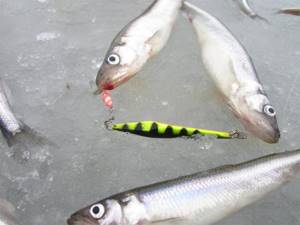
Catching smelt
Ice fishing
Successful smelt fishing does not require special knowledge of the reservoir. The location of a school is easily tracked by the abundance of people in a particular area of a lake, river or frozen bay. Standard fishing depths are 4–8 meters, but often reach 20–30 meters. In cold water, the fish tries to stay close to the bottom, but does not sink to the ground. The greatest number of bites occurs in the bottom layer, when the bait has almost reached its maximum immersion or has just begun to rise.
The modest dimensions of the smelt fish determine the simplicity and accessibility of the gear:
- light winter fishing rod with a spool or reel;
- a significant supply of thin monofilament with a thickness of 0.1-0.16 mm;
- sensitive nod;
- small jig with a diameter of 3–5 mm.
If borage fishing is carried out at significant depths or currents, you should use a stiffer fishing rod, a fishing line up to 0.2-0.25 mm thick and installation with a retractable leash, which involves installing a sinker weighing 20–40 g. As a catchable bait on Bloodworms, maggots, worms, pieces of fresh perch or ruff have proven themselves to be excellent for smelt.
The predatory inclinations of the fish provide the opportunity for spectacular fishing with small spinners 5–6 mm long of silver, gray or copper color, which are often complemented by bright “plumage”. At the same time, the beard is cut off from the hook, so that during intense biting you do not waste extra time pulling the sting out of the bony mouth of the small fish.
Open water fishing
Occurs from the shore, bridge, pier or boat at depths of 3–5 meters. The most active bite is in April - May and September - October.
To learn more:
Fish of the flounder family: description of varieties
Three types of gear are used:
- Ultralight spinning rod with a spinning reel and a small spinner.
- Classic donka with 4–5 phosphorus jigs.
- Sensitive feeder rod with “tyrant” equipment – 3–5 shiny hooks No. 16–18 on short double leads with pieces of red latex or threads attached. A flat sinker or a large spoon is tied to the main line, which, when moving vertically, oscillates from side to side, giving a “fun” game to the hooks.
In addition to inedible baits, you can successfully catch smelt in the summer using natural baits - bloodworms, worms, maggots, strips of fresh perch, crucian carp, ruffe.
Soup
Far Eastern smelt soup, the recipe for which we offer, is very aromatic and satisfying.

Cooking will not take much time, and the pleasure of eating this soup will be guaranteed.
- The first step is to prepare a broth base from potatoes and onions. Take two large potatoes and a medium-sized onion. Cut into convenient pieces, throw them into boiling water, add parsley and a little celery.
- After the base has boiled, you need to add peppercorns (four of them are enough), a couple of bay leaves, nutmeg and salt.
- Ten smelts need to be peeled and added to the soup after the potatoes have become soft.
- After boiling, cook for no more than three minutes, remove bay leaves and pepper.
- You can decorate the soup with herbs.
Cooking smelt
Speaking about cooking smelt, an interesting fact should be noted. An entire holiday is dedicated to this fish. This fish received such an honor due to the fact that during the siege of Leningrad it saved people from starvation .
In stores you can buy fresh frozen smelt, smoked or salted. It is easy to clean. Does not require any additional processing.
In culinary terms, smelt is a universal fish, so to speak. There are no small bones in it, the meat is easily separated from the backbone, so it cannot be called bony. Due to the fact that the backbone of this fish is very soft when cooked, it can be eaten whole. Thanks to this same property, this fish is suitable as a filling for kulebyak.
As for other dishes, it should be noted that smelt turns out tasty if you fry it until crispy. The fish soup from it turns out to be insufficiently rich, so fish soup is practically not made from it. If it is added to the fish soup, then it is mixed with other fattier fish.
In addition to the fact that this fish can be fried and boiled, it turns out very tasty when stewed. To prepare stewed smelt , you first need to gut it, as usual. Then it must be thoroughly washed, placed in a frying pan and salted. For taste, you can also add finely chopped onions. Then add oil and water in a 1:1 ratio. Simmer over low heat. The important thing in this matter is that it boils quickly, so it is recommended to simmer it for no more than 5 minutes.
Fried smelt
This is the most common dish, which, like soup, can be prepared in a matter of minutes. You can fry Far Eastern smelt using the usual method, or you can also fry it in batter. Let's consider both options.
Regular way:
- Clean the fish, decapitate it, and roll it in a mixture of flour and salt.
- Place in a hot frying pan with vegetable oil, cover with a lid.
- Fry each side for five minutes.
Breaded:
- Sprinkle the cleaned fish with salt and put it in the refrigerator for an hour.
- Mix the egg with milk (one tablespoon of milk per egg).
- Dip the fish into the egg and milk mixture, then into the flour.
- Fry until the batter is golden brown, covered.

Smelt
This flapping can be seen from afar, and during the low-biting period, successful fishermen wind the line around their slightly outstretched hands so as not to attract a horde of losers. Rarely does anyone choose a fishing line in a tug like an anchor; a fast smelt will overtake and throw out a hook that does not have a barb. Of course, you can use a hook with a barb. But you won't catch more fish from this.
Firstly, the bend of an ordinary hook does not correspond to the conditions for catching smelt, which means that the number of fish hooks will be less. Secondly, whether there is a beard or not, you need to pull the prey onto the ice quickly, instantly shake it off and lower the spoon again before the seduced flock moves away and loses interest. All this must be done with a fishing line wound around both hands, which can be 15-20 m.
The slightest mistake - and these meters will get together in a lump, in such a “beard” that it is not worth trying to untangle in the cold. This is exactly what happens to the most reckless anglers. So barbed hooks have no advantage.
Tyrant is a different matter, here instead of speed you need to be careful not to catch the hook on the ice, and after a bite the fisherman most often puts the rod next to him and selects thin tackle with his hands, throwing the selected meters to the side or into the wind. That's why tyrants wear hooks with barbs. Now more and more anglers are trying to fish with tyrants.
An ordinary tyrant has six hooks. Tied every 30 cm, they fish a two-meter layer of water, and the likelihood of meeting fish and bait increases. But this is an imaginary advantage. Fishing with a tyrant is even more difficult than with spoons. Of course, if there are a lot of fish, then any tackle turns out to be catchy. But such reckless gluttony happens less and less now.
Baking
There are several ways to prepare baked smelt; let’s look at two that you’ll definitely like.
Simple recipe:
- We clean the fish, rub it with paprika, coriander and chopped garlic, don’t forget about salt.
- Place the carcasses on a greased baking dish and sprinkle with a little lemon juice.
- The oven temperature should be 220 degrees, bake for twenty minutes.
Baking for sauce lovers:
- Place half a kilo of tomatoes canned in their own juice on a baking sheet, mix with a little salt, add a teaspoon of sugar and herbs.
- Place cleaned, pre-fried smelt on top.
- Place chopped garlic and whole cherry tomatoes (about 300 grams) on the fish.
- Sprinkle a little vegetable oil and bake for 40 minutes at 180 degrees.
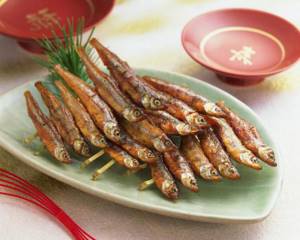
Tackle
Regular winter fishing rods are used - purchased and homemade. The most common equipment is the tyrant. This is a piece of thin fishing line (approximately a meter long) with a diameter of 0.12 - 0.14 mm, on which a garland of two to five small hooks No. 16 - 20 according to Western European numbering (No. 2, 5 - 5 according to domestic standards). It is important that the hooks dangle freely in a small loop on the leash. Leads with a diameter of 0.15 - 0.22 mm. Sinkers - from a few grams to 50 g (for rivers with fast currents or for fishing at low tide).
Bait - sea worm, maggot (often tinted red or green), pieces of shrimp. Smelt readily bites both on cut beef and on itself. Artificial baits include pieces of foam rubber in lemon, light green and green colors, and mohair threads of the same color. Nowadays, fishing stores offer imported tyrants with a variety of multi-colored “flies” or wabiki.
Along with tyrants, it is popular to catch smelt using spoons (dump trucks), which are used to catch both without weight and with sinkers. Moreover, in different years, smelt has been noted to love certain forms of spinners, on which they also attach a mohair “butterfly” in different combinations of lemon and green colors using a millimeter piece of cambric (usually red). When the bite is really bad, you can use lures with chopped smelt or fresh herring.
To prevent the cutting from flying off the spoon, it is fixed with a piece of foam rubber. In this case, it is convenient to replace the “dump trucks” with heavy spoons with hooks. Although science says that fish see everything in black and white, why then does the color of the spinners affect their catchability? Smelt is no exception. Smelt bite best on white baits - made of silver and cupronickel (stainless steel is much worse) - and yellow ones made of brass. Less common, but still available in the arsenal of a few anglers are spoons made of copper.
Combined spinners, which are labor-intensive to manufacture, have proven themselves well - combinations of cupronickel, brass, and copper. As I already noted, the shape of the spoon is of great importance. In the 60s and 70s, when smelt was found in abundance, it could be caught, as they say, with a nail. Over time, I had to experiment in search of a catchable form, and it was found. If you have to fish on rivers with strong tidal currents (for example, on the Bolshaya River), you can use a fishing line 30-50 cm higher than the spinner and attach a sliding sinker “olive” using thick wire and cambrics.
Dried Far Eastern smelt
This is a favorite treat for men with beer. Let's consider the simplest recipe so that extra flavors do not interrupt the main one.
- Pour water into a container and add salt well. Determine the amount of salt using peeled potatoes. Place it in water, add salt little by little, stirring constantly. The potatoes have floated - there is enough salt.
- Next, add soy sauce (for 12 liters of water - 320 milliliters of sauce).
- Place the fish in the sauce, cover with a weight (5-6 kilograms).
- After five hours, add a tablespoon of vinegar.
- After an hour, remove the fish, rinse well under running water, and leave for an hour to drain.
- After this, the carcasses need to be rinsed in slightly sweetened water and allowed to drain again.
- You should hang the fish only in a well-ventilated area.
So, we have looked at the simplest and most popular recipes for preparing Far Eastern smelt, now let’s see why it should be eaten.
Smelt
This determines the nature of the wiring. The first task is to lure the fish, the second is to provoke a bite. You need to lure the fish in the water horizon where it hunts. In the classic situation, navaga does this at the bottom, catfish smelt ( Zubar ) - in a layer up to one meter above the bottom, smallmouth - from one and a half to two meters. But true fishermen never talk about meters and centimeters.
“From the bottom,” says the fisherman and lowers the fishing rod to the ice at knee level. At this time, in his opinion, the spoon should touch the bottom. “Three turns” means that the spoons are raised to a height of about a meter. Despite the approximate nature of such estimates, the accuracy of getting into the “fish layer” is high. It is important to line up the fish in a certain place with three to five identical movements, and then, lowering the spoons a little lower, provoke a bite.
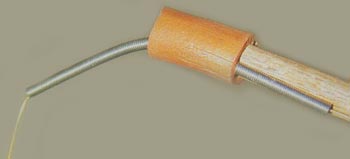
The spring nod should bend halfway under the weight of the sinker
In practice, this is achieved with a slight nod of the fishing rod, as if trying to hook an invisible fish. The swing of the fishing rod and the depth of the bait's fall are determined by the distance to the bottom, the strength of the current, the ratio of the weight of the sinker and the resistance of the main line, the weight of the spoon and the parameters of the leash.
There are other, less obvious, components, so it is no wonder that among the fishermen huddled together like a flock of penguins, only a few people successfully catch, while the rest are just present. They tell a story about how one inexperienced fisherman bought first spoons, then fishing rods, and finally holes from his grandfather, who was successful in fishing, but was left with nothing.
I also knew such specialists who approached the loser, asked permission to try and pulled out one, two, third fish from his own hole that had been silent since the morning. Feeling a fish hanging on the spoon, the angler wraps the fishing line around his widely spread hands - “waves”. They say about a good bite: “everyone waved.”
Benefits of smelt
This fish is fatty and filling, but quite low in calories. One hundred grams contains about 100 kcal, so it will not add excess weight.
Smelt is very beneficial for health. It contains:
- Proteins, fatty acids.
- Vitamins D and PP.
- High potassium content, therefore useful for people with heart and vascular diseases.
- Calcium, iron, phosphorus (also contained in large quantities).
- Magnesium, sulfur, fluorine, sodium, chromium, nickel, molybdenum and chlorine.
Smelt is good for everyone to eat, including children.
Smelt
And for the “tyrants” the problem of stopping, luring, provoking a grip has become urgent. It is easier to stop a school of fish with the help of a tyrant, since in the fisherman’s hand there is a sort of playing school of shiny hooks, which the fish can mistake for food. Migrating across the sea and entering rivers, smelt encounters different aquatic organisms and can only find out through experience whether they are suitable for food or not.
Therefore, she will try everything that seems edible to her, but it is still better if the tyrant’s hooks imitate prey known to the fish. Prey can be imitated by color, taste, smell and type of movement. The latter is most important and is achieved by wiring. Common wiring is based on two actions: quiet fusion and sharp jerky movements.
This is how many small aquatic animals move in water, mysids, for example. They move with a push, and then either slowly sink or float down the stream. This is exactly what the angler imitates when he first twitches the tackle and then slowly lowers the rod. After a second and a half, he again makes a slight twitch, and repeats this until the sinker touches the bottom.
At this point, the dive stops, the line is weakened to the point of obvious slack, followed by a short hook. After hooking, the stepwise dive is repeated. At the beginning of fishing or when the bite worsens, it makes sense to make several empty long hooks to attract fish from afar, and then fish again as usual.
In severe frost, when the bites become very cautious, a nod is installed on the fishing rod. Usually this is a spring device adjusted so that the sinker bends the nod halfway. If the bite occurs during a slow dive, the nod begins to gradually straighten, and then you need to urgently hook.
A hungry smelt takes it sharply - the nod twitches, a large catfish ( Zubar ) during intensive feeding “presses” the tip of the fishing rod, and navaga can tear the fishing rod out of a relaxed hand. On reservoirs with a current, I used the following equipment: at the junction of the main fishing line with the tyrant’s leash, I put on a thick cambric or attached a piece of foam rubber to create resistance to the flow.
After a short twitch (do not lift the sinker from the bottom!) the line weakens, causing the upper hooks to float downstream and slowly sink, the fish takes them and is hooked at the moment of twitching. Typically, smelt are caught on top hooks, which have a larger drift zone. The color of the bait has a certain meaning. Most often, fish bite on shiny white hooks tipped with a green strip of thin latex (Mobixin).
